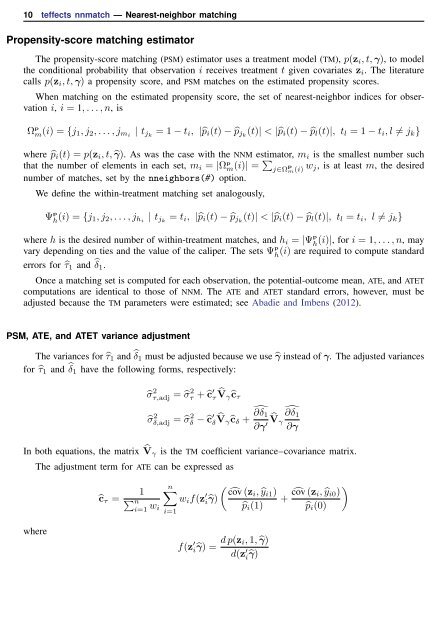teffects nnmatch - Stata
teffects nnmatch - Stata
teffects nnmatch - Stata
Create successful ePaper yourself
Turn your PDF publications into a flip-book with our unique Google optimized e-Paper software.
10 <strong>teffects</strong> <strong>nnmatch</strong> — Nearest-neighbor matching<br />
Propensity-score matching estimator<br />
The propensity-score matching (PSM) estimator uses a treatment model (TM), p(z i , t, γ), to model<br />
the conditional probability that observation i receives treatment t given covariates z i . The literature<br />
calls p(z i , t, γ) a propensity score, and PSM matches on the estimated propensity scores.<br />
When matching on the estimated propensity score, the set of nearest-neighbor indices for observation<br />
i, i = 1, . . . , n, is<br />
Ω p m(i) = {j 1 , j 2 , . . . , j mi | t jk = 1 − t i , |̂p i (t) − ̂p jk (t)| < |̂p i (t) − ̂p l (t)|, t l = 1 − t i , l ≠ j k }<br />
where ̂p i (t) = p(z i , t, ̂γ). As was the case with the NNM estimator, m i is the smallest number such<br />
that the number of elements in each set, m i = |Ω p m(i)| = ∑ j∈Ω p m(i) w j, is at least m, the desired<br />
number of matches, set by the nneighbors(#) option.<br />
We define the within-treatment matching set analogously,<br />
Ψ p h (i) = {j 1, j 2 , . . . , j hi | t jk = t i , |̂p i (t) − ̂p jk (t)| < |̂p i (t) − ̂p l (t)|, t l = t i , l ≠ j k }<br />
where h is the desired number of within-treatment matches, and h i = |Ψ p h<br />
(i)|, for i = 1, . . . , n, may<br />
vary depending on ties and the value of the caliper. The sets Ψ p h<br />
(i) are required to compute standard<br />
errors for ̂τ 1 and ̂δ 1 .<br />
Once a matching set is computed for each observation, the potential-outcome mean, ATE, and ATET<br />
computations are identical to those of NNM. The ATE and ATET standard errors, however, must be<br />
adjusted because the TM parameters were estimated; see Abadie and Imbens (2012).<br />
PSM, ATE, and ATET variance adjustment<br />
The variances for ̂τ 1 and ̂δ 1 must be adjusted because we use ̂γ instead of γ. The adjusted variances<br />
for ̂τ 1 and ̂δ 1 have the following forms, respectively:<br />
̂σ 2 τ,adj = ̂σ 2 τ + ĉ ′ τ ̂V γ ĉ τ<br />
̂σ δ,adj 2 = ̂σ δ 2 − ĉ ′ ̂V δ γ ĉ δ + ̂∂δ 1 ̂V<br />
̂∂δ1<br />
∂γ ′ γ<br />
∂γ<br />
In both equations, the matrix ̂V γ is the TM coefficient variance–covariance matrix.<br />
The adjustment term for ATE can be expressed as<br />
ĉ τ =<br />
1<br />
∑ n<br />
i=1 w i<br />
n∑<br />
i=1<br />
( ĉov<br />
w i f(z ′ (zi , ŷ i1 )<br />
îγ)<br />
+ ĉov (z )<br />
i, ŷ i0 )<br />
̂p i (1) ̂p i (0)<br />
where<br />
f(z ′ îγ) = d p(z i, 1, ̂γ)<br />
d(z ′ îγ)

















